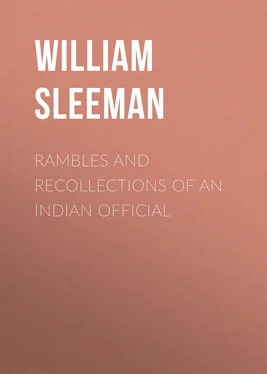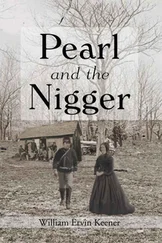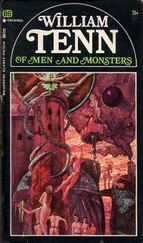William Sleeman - Rambles and Recollections of an Indian Official
Здесь есть возможность читать онлайн «William Sleeman - Rambles and Recollections of an Indian Official» — ознакомительный отрывок электронной книги совершенно бесплатно, а после прочтения отрывка купить полную версию. В некоторых случаях можно слушать аудио, скачать через торрент в формате fb2 и присутствует краткое содержание. Жанр: Путешествия и география, История, foreign_edu, foreign_antique, foreign_prose, на английском языке. Описание произведения, (предисловие) а так же отзывы посетителей доступны на портале библиотеки ЛибКат.
- Название:Rambles and Recollections of an Indian Official
- Автор:
- Жанр:
- Год:неизвестен
- ISBN:нет данных
- Рейтинг книги:4 / 5. Голосов: 1
-
Избранное:Добавить в избранное
- Отзывы:
-
Ваша оценка:
- 80
- 1
- 2
- 3
- 4
- 5
Rambles and Recollections of an Indian Official: краткое содержание, описание и аннотация
Предлагаем к чтению аннотацию, описание, краткое содержание или предисловие (зависит от того, что написал сам автор книги «Rambles and Recollections of an Indian Official»). Если вы не нашли необходимую информацию о книге — напишите в комментариях, мы постараемся отыскать её.
Rambles and Recollections of an Indian Official — читать онлайн ознакомительный отрывок
Ниже представлен текст книги, разбитый по страницам. Система сохранения места последней прочитанной страницы, позволяет с удобством читать онлайн бесплатно книгу «Rambles and Recollections of an Indian Official», без необходимости каждый раз заново искать на чём Вы остановились. Поставьте закладку, и сможете в любой момент перейти на страницу, на которой закончили чтение.
Интервал:
Закладка:
CHAPTER 8
92 92 This is a slip, probably due to the printer's reader. There are no chimney-sweepers in India. The word should be 'sweepers'. The members of this caste and a few other degraded communities, such as the Doms, do all the sweeping, scavenging, and conservancy work in India. 'Washerwomen' is another slip: read 'Washermen'.—Elephant Drivers
Mīr Salāmat Alī, the head native collector of the district, a venerable old Musalmān and most valuable public servant, who has been labouring in the same vineyard with me for the last fifteen years with great zeal, ability, and integrity, came to visit me after breakfast with two very pretty and interesting young sons. While we were sitting together my wife's under-woman 93 93 The 'under-woman', or 'second ayah', was a member of the sweeper caste.
said to some one who was talking with her outside the tent-door, 'If that were really the case, should I not be degraded?' 'You see, Mīr Sāhib', 94 94 The title Mīr Sāhib implies that Salāmat Alī was a Sayyid, claiming descent from Alī, the cousin, son-in-law, and pupil of Muhammad, who became Khalīf in A.D. 656.
said I, 'that the very lowest members of society among these Hindoos still feel the pride of caste, and dread exclusion from their own, however low.' 95 95 The sweeper castes stand outside the Hindoo pale, and often incline to Muhammadan practices. They worship a special form of the Deity, under the names of Lāl Beg, Lāl Guru, &c.
'Yes', said the Mīr, 'they are a very strange kind of people, and I question whether they ever had a real prophet among them.'
'I question, Mīr Sahib, whether they really ever had such a person. They of course think the incarnations of their three great divinities were beings infinitely superior to prophets, being in all their attributes and prerogatives equal to the divinities themselves. 96 96 No avatār or incarnation of Brahma is known to most Hindoos, and incarnations of Siva are rarely mentioned. The only avatārs ordinarily recognized are those of Vishnu, as enumerated ante. Chapter 2, note 4.
But we are disposed to think that these incarnations were nothing more than great men whom their flatterers and poets have exalted into gods—this was the way in which men made their gods in ancient Greece and Egypt. These great men were generally conquerors whose glory consisted in the destruction of their fellow creatures; and this is the glory which their flatterers are most prone to extol. All that the poets have sung of the actions of men is now received as revelation from heaven; though nothing can be more monstrous than the actions attributed to the best incarnation, Krishna, of the best of their gods, Vishnu. 97 97 This theory is a very inadequate explanation of the doctrine of avatārs .
'No doubt', said Salāmat Ali; 'and had they ever had a real prophet among them he would have revealed better things to them. Strange people! when their women go on pilgrimages to Gayā, they have their heads shaved before the image of their god; and the offering of the hair is equivalent to the offer of their heads; 98 98 'Women . . . are most careful to preserve their hair intact. They pride themselves on its length and weight. For a woman to have to part with her hair is one of the greatest of degradations, and the most terrible of all trials. It is the mark of widowhood. Yet in some sacred places, especially at the confluence of rivers, the cutting off and offering of a few locks of hair (Venī- dānam ) by a virtuous wife is considered a highly meritorious act' (Monier Williams, Religious Thought and Life in India , p, 375). Gayā in Bihār, fifty-five miles south of Patna, is much frequented by pilgrims devoted to Vishnu.
for heads, thank God, they dare no longer offer within the Company's territories.'
'Do you. Mīr Sahib, think that they continue to offer up human sacrifices anywhere?'
'Certainly I do. There is a Rājā at Ratanpur, or somewhere between Mandlā and Sambalpur, who has a man offered up to Dēvī every year, and that man must be a Brahman. If he can get a Brahman traveller, well and good; if not, he and his priests offer one of his own subjects. Every Brahman that has to pass through this territory goes in disguise. 99 99 All the places named are in the Central Provinces. Ratanpur, in the Bilāspur District, is a place of much antiquarian interest, full of ruins; Mandlā, in the Mandlā District, was the capital of the later Gond chiefs of Garhā Mandlā; and Sambalpur is the capital of the Sambalpur District. If the story is true, the selection of a Brahman for sacrifice is remarkable, though not without precedent. Human sacrifice has prevailed largely in India, and is not yet quite extinct. In 1891 some Jāts in the Muzaffarnagar District of the United Provinces sacrificed a boy in a very painful manner for some unascertained magical purpose. It was supposed that the object was to induce the gods to grant offspring to a childless woman. Other similar cases have occurred in recent years. One occurred close to Calcutta in 1892. In the hill tracts of Orissa bordering on the Central Provinces the rite of human sacrifice was practised by the Khonds on an awful scale, and with horrid cruelty, It was suppressed by the special efforts of Macpherson, Campbell, MacViccar, and other officers, between the years 1837 and 1854. Daring that period the British officers rescued 1,506 victims intended for sacrifice (Narrative of Major-General John Campbell, C.B., of his Operations in the Hill Tracts of Orissa for the Suppression of Human Sacrifices and Female Infanticide . Printed for private circulation. London: Hurst and Blackett, 1861). The rite, when practised by Hindoos, may have been borrowed from some of the aboriginal races. The practice, however, has been so general throughout the world that few peoples can claim the honour of freedom from the stain of adopting it at one time or another, Much curious information on the subject, and many modern instances of human sacrifices in India, are collected in the article 'Sacrifice' in Balfour, Cyclopaedia of India , 3rd edition, 1885. Major S. C. Macpherson, Memorials of Service in India (1865), and Frazer, Golden Bough , 3rd edition, Part V, vol. i (1912), pp. 236 seq., may also be consulted.
With what energy did our emperor Aurangzēb apply himself to put down iniquities like this in the Rājputāna states, but all in vain. If a Rājā died, all his numerous wives burnt themselves with his body—even their servants, male and female, were obliged to do the same; for, said his friends, what is he to do in the next world without attendants? The pile was enormous. On the top sat the queen with the body of the prince; the servants, male and female, according to their degree, below; and a large army stood all round to drive into the fire again or kill all who should attempt to escape.' 100 100 Bernier vividly describes an 'infernal tragedy' of this kind which he witnessed, in or about the year 1659, during Aurangzēb's reign, in Rājputāna. On that occasion five female slaves burnt themselves with their mistress (Travels , ed. Constable and V. A. Smith (1914), p. 309).
'This is all very true, Mīr Sāhib, but you must admit that, though there is a great deal of absurdity in their customs and opinions, there is, on the other hand, much that we might all take an example from. The Hindoo believes that Christians and Musalmāns may be as good men in all relations of life as himself, and in as fair a way to heaven as he is; for he believes that my Bible and your Korān are as much revelations framed by the Deity for our guidance, as the Shāstras are for his. He doubts not that our Christ was the Son of God, nor that Muhammad was the prophet of God; and all that he asks from us is to allow him freely to believe in his own gods, and to worship in his own way. Nor does one caste or sect of Hindoos ever believe itself to be alone in the right way, or detest any other for not following in the same path, as they have as much of toleration for each other as they have for us. 101 101 Hinduism is a social system, not a creed, A Hindoo may believe, or disbelieve, what speculative doctrine he chooses, but he must not eat, drink, or marry, save in accordance with the custom of his caste. Compare Asoka on toleration; 'The sects of other people all deserve reverence for one reason or another' (Rock Edict xii; V. A. Smith, Asoka , 2nd edition (1909), p. 170).
Интервал:
Закладка:
Похожие книги на «Rambles and Recollections of an Indian Official»
Представляем Вашему вниманию похожие книги на «Rambles and Recollections of an Indian Official» списком для выбора. Мы отобрали схожую по названию и смыслу литературу в надежде предоставить читателям больше вариантов отыскать новые, интересные, ещё непрочитанные произведения.
Обсуждение, отзывы о книге «Rambles and Recollections of an Indian Official» и просто собственные мнения читателей. Оставьте ваши комментарии, напишите, что Вы думаете о произведении, его смысле или главных героях. Укажите что конкретно понравилось, а что нет, и почему Вы так считаете.












